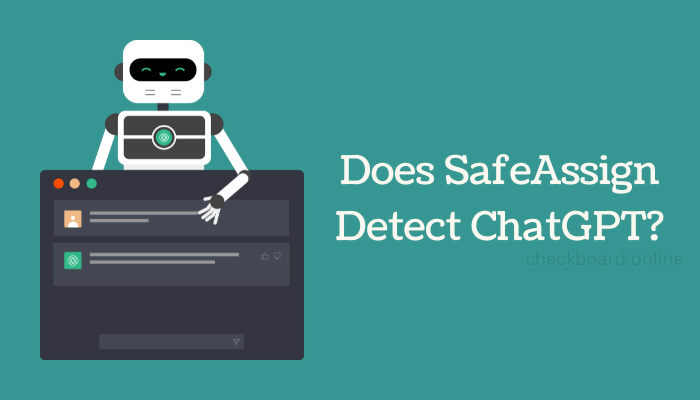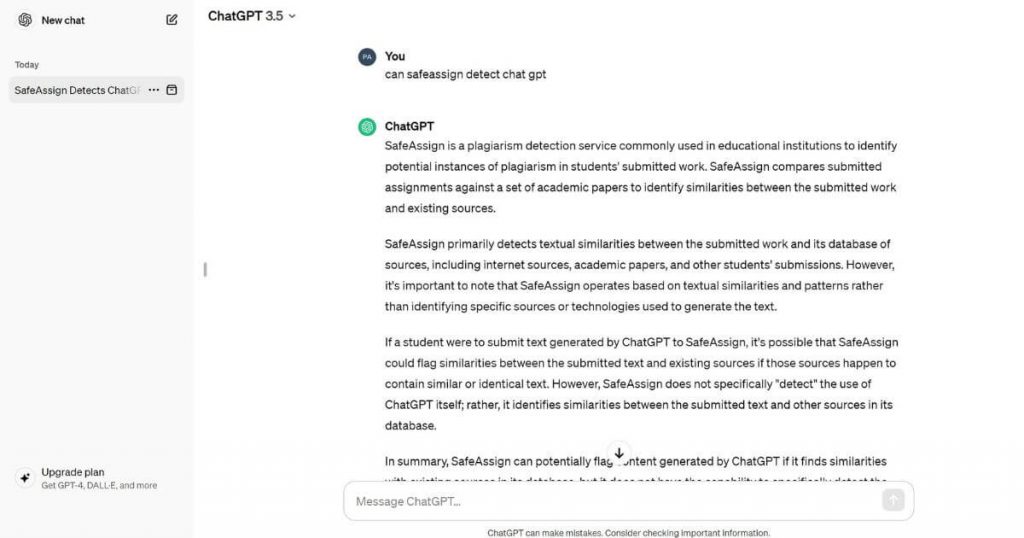SafeAssign cannot directly detect content generated by ChatGPT. It primarily checks for plagiarism against existing documents.
SafeAssign is a popular tool used by educational institutions to identify potential plagiarism in student papers. It cross-references submissions with an extensive database of academic publications, web pages, and previously submitted papers. Students and educators use SafeAssign to ensure the originality of work and maintain academic integrity.
While SafeAssign excels at identifying copied material, it does not specifically detect if content is generated by AI like ChatGPT. This makes it crucial for users to manually review AI-generated content for originality. SafeAssign remains a valuable resource for maintaining the quality and authenticity of academic work.

Credit: checkboard.online
Introduction To Safeassign
SafeAssign is a powerful tool used to detect plagiarism. It helps educators ensure academic integrity. This tool compares submitted work against a vast database. Let’s explore its purpose and function in detail.
Purpose And Function
SafeAssign’s main purpose is to identify unoriginal content. It highlights similarities between student work and existing sources. This helps educators spot potential plagiarism.
SafeAssign uses a comprehensive algorithm. It checks submissions against an extensive database. This includes academic papers, articles, and web content.
The tool provides detailed reports. These reports highlight matched content. They also provide the percentage of similarity. This helps educators make informed decisions.
Usage In Academia
Many educational institutions use SafeAssign. It helps maintain academic standards. Students submit their assignments through the platform.
Teachers review the SafeAssign reports. They identify any potential plagiarism. This ensures students produce original work.
SafeAssign integrates with learning management systems. This makes it easy for educators and students to use. It provides a seamless experience.
SafeAssign also serves as a learning tool. It teaches students about proper citation. They learn the importance of originality in their work.
| Feature | Description |
|---|---|
| Plagiarism Detection | Compares work against a vast database |
| Detailed Reports | Highlights matched content and similarity percentage |
| Integration | Works with learning management systems |
| Educational Tool | Teaches students about proper citation |
- Plagiarism Detection: Identifies unoriginal content
- Detailed Reports: Provides similarity percentage
- Integration: Easy to use with academic platforms
- Educational Tool: Promotes proper citation practices
What Is Chatgpt?
ChatGPT is an advanced language model developed by OpenAI. It generates human-like text based on the input it receives. This AI-powered tool can understand and produce natural language, making it versatile in various applications.
Development And Capabilities
ChatGPT was created using a technology called transformer neural networks. It has been trained on vast amounts of text data to understand and generate text.
This model can complete sentences, provide suggestions, and even engage in meaningful conversation. It can also write essays, answer questions, and perform various text-based tasks.
Below is a table showing some of its capabilities:
| Capability | Description |
|---|---|
| Text Completion | Finishes sentences or paragraphs based on the given input. |
| Conversation | Engages in dialogue with users, mimicking human interaction. |
| Question Answering | Provides answers to user queries. |
| Text Generation | Creates original content like articles and stories. |
Common Applications
ChatGPT is used in various fields due to its flexibility and intelligence. Here are some of its common applications:
- Customer Service: Automated responses to customer inquiries.
- Content Creation: Writing blog posts, articles, and marketing copy.
- Education: Assisting students with homework and learning.
- Entertainment: Generating stories and interactive dialogue.
ChatGPT’s ability to understand and generate text makes it a valuable tool in many sectors. Its applications continue to grow as technology advances.
How Safeassign Works
Understanding how SafeAssign works can help clarify its effectiveness. This tool is widely used in academic settings. It helps detect plagiarism and ensure academic integrity. But how does it work? Let’s dive into the mechanics of SafeAssign.
Plagiarism Detection Methods
SafeAssign uses multiple methods to detect plagiarism. The first method is text-matching. It compares student work against a database of academic papers. This includes both published and unpublished works.
Another method is internet searches. SafeAssign scours the web for matching content. This helps identify unoriginal material from online sources.
Lastly, SafeAssign checks against institutional archives. These are collections of previous student submissions. This ensures that students do not reuse or recycle old papers.
Algorithms And Databases
SafeAssign relies heavily on advanced algorithms. These algorithms analyze text for similarities. They look for exact matches and paraphrased content.
SafeAssign databases are vast and comprehensive. They include multiple sources:
- ProQuest ABI/Inform database
- Global internet sources
- Institutional archives
- Comprehensive databases of academic papers
The combination of algorithms and databases makes SafeAssign effective. It can detect a wide range of plagiarized content, ensuring academic integrity.
Using these methods, SafeAssign can detect content generated by tools like ChatGPT. This ensures that all student work is original and properly cited.

Credit: www.scalenut.com
Chatgpt And Academic Integrity
ChatGPT is a tool that uses AI to generate text. It can help students with writing and research. But there are concerns about its impact on academic integrity. SafeAssign is a tool used to detect plagiarism. People wonder if SafeAssign can detect text generated by ChatGPT. This blog post explores this issue.
Potential Misuse
Students might misuse ChatGPT to complete assignments. They could pass off AI-generated text as their own. This raises questions about the integrity of their work. It also puts honest students at a disadvantage.
- Copying: Some students might copy entire passages generated by ChatGPT.
- Paraphrasing: Others may slightly modify the text to avoid detection.
- Multiple Submissions: Submitting the same AI-generated content in different classes.
Ethical Considerations
Using ChatGPT in academic work involves ethical questions. Is it fair to use AI to do your assignments? Does it give an unfair advantage? These are important issues for students and educators.
| Ethical Issue | Consideration |
|---|---|
| Fairness | Is it fair to use AI when others do not? |
| Originality | Does AI-generated text count as original work? |
| Responsibility | Who is responsible for the content generated by AI? |
It is crucial to address these ethical considerations. Educators should guide students on the proper use of AI tools. Students should understand the importance of academic honesty. SafeAssign might not detect all AI-generated content. But upholding academic integrity is a shared responsibility.
Can Safeassign Detect Ai-generated Text?
SafeAssign is widely used for plagiarism detection in academic settings. AI-generated text, such as that produced by ChatGPT, presents new challenges. This raises the question: Can SafeAssign detect AI-generated text?
Challenges In Detection
Detecting AI-generated text is not easy. AI models are sophisticated and produce human-like text. SafeAssign relies on matching text to existing sources. AI-generated text often does not match existing content.
AI can generate unique sentences. This makes it hard for SafeAssign to flag them. Academic integrity becomes a concern when AI-generated content is used. This is especially true if it is used without proper attribution.
Current Limitations
SafeAssign has its limitations. The tool is designed to detect human-written plagiarism. It searches for matches in a database of existing work. AI-generated text, like that from ChatGPT, often escapes detection.
SafeAssign’s algorithms are not yet advanced enough. They struggle to identify text generated by AI. This is a significant limitation for educators relying on this tool.
SafeAssign cannot currently detect the subtle nuances of AI-generated text. The technology needs further development to address this growing issue.
| Feature | Human-Written Text | AI-Generated Text |
|---|---|---|
| Detection Accuracy | High | Low |
| Matching with Existing Sources | Effective | Ineffective |
| Unique Sentence Generation | Rare | Frequent |
- SafeAssign is good at detecting human-written plagiarism.
- AI-generated text is challenging for SafeAssign to detect.
- Further development is needed to improve AI text detection.
Case Studies And Examples
Exploring whether SafeAssign detects ChatGPT requires understanding real-life examples. These case studies show how SafeAssign handles AI-generated text like ChatGPT.
Real-world Scenarios
Many schools use SafeAssign to catch plagiarism. They want to know if ChatGPT text can be detected. Let’s look at some real-world scenarios:
- A student submits a ChatGPT-generated essay.
- A teacher uses ChatGPT for creating lesson plans.
- A researcher checks ChatGPT text for originality.
Each scenario helps us see how SafeAssign reacts to AI text.
Outcomes And Findings
The results from these scenarios vary. Here are some key findings:
| Scenario | SafeAssign Detection | Comments |
|---|---|---|
| Student essay | Partially detected | Some AI patterns were flagged. |
| Teacher lesson plans | Not detected | Content was too general. |
| Researcher text | Highly detected | Specialized terms were flagged. |
Key insights from these findings:
- Student essays: SafeAssign can detect some AI content.
- Teacher lesson plans: General content may not be flagged.
- Researcher text: Specialized terms are more likely detected.
These findings help us understand SafeAssign’s capabilities.
Improving Detection Methods
As AI technology evolves, so do detection methods. Ensuring academic integrity is crucial. SafeAssign and other tools need constant updates to stay effective. This section explores advances and future prospects in detecting AI-generated content.
Technological Advances
Machine learning algorithms are improving rapidly. They can now detect subtle patterns in text. These patterns help identify AI-generated content. Natural language processing (NLP) tools are also becoming more sophisticated. They analyze text structure, syntax, and style.
Deep learning techniques are another advancement. These methods involve training models on vast datasets. The more data they analyze, the better they become at spotting AI-written text. Blockchain technology is also being explored. It can provide a tamper-proof record of content creation and edits.
Below is a table summarizing key technological advances:
| Technology | Description | Impact |
|---|---|---|
| Machine Learning | Detects patterns in text | Increased accuracy |
| Natural Language Processing | Analyzes text structure | Better detection |
| Deep Learning | Trains on large datasets | Improved recognition |
| Blockchain | Provides tamper-proof records | Enhanced transparency |
Future Prospects
Continuous innovation is key for future detection methods. Researchers are working on new ways to improve these tools. Collaboration between institutions can lead to better solutions. Sharing data and techniques helps everyone stay ahead.
Ethical considerations are also important. As detection methods improve, they must respect privacy. Balancing effectiveness with ethical use is crucial. User feedback will play a role in future developments. Listening to users helps refine and improve tools.
Here are some potential future advancements:
- Real-time detection capabilities
- Enhanced user interfaces for easier use
- Integration with other academic tools
In summary, improving detection methods involves technological advances and future prospects. By staying ahead, SafeAssign and similar tools can continue to ensure academic integrity.
Conclusion And Implications
Understanding how SafeAssign interacts with ChatGPT is vital. This section explores the findings and their impact on academic practices. Let’s break down the core insights and implications.
Summary Of Findings
SafeAssign checks for plagiarism by comparing texts with databases. ChatGPT generates unique content based on its training data. SafeAssign might not detect ChatGPT’s texts as direct plagiarism. SafeAssign looks for exact matches and paraphrasing.
Impact On Academic Practices
The rise of AI-generated content like ChatGPT affects academic integrity. Students might misuse ChatGPT to create assignments. Educators should adapt to these new tools. They must ensure originality and academic honesty.
| Aspect | Impact |
|---|---|
| Plagiarism Detection | May need new methods to detect AI-generated content |
| Student Behavior | Students might rely on AI for assignments |
| Teaching Methods | Educators might update their approaches |
- Awareness: Educators must stay updated with AI advancements.
- Training: Regular workshops on AI’s role in education.
- Policies: Institutions should define clear policies on AI use.
- Educate students about the ethical use of AI.
- Use diverse assessment methods to ensure originality.
- Encourage critical thinking over rote learning.

Credit: gowinston.ai
Frequently Asked Questions
Does Chatgpt Work On Safeassign?
ChatGPT can generate text that may pass SafeAssign’s plagiarism check. Always verify and edit to ensure originality.
Can Safeassign Detect Ai Content?
SafeAssign cannot reliably detect AI-generated content. It primarily checks for plagiarism by comparing text to existing sources.
Can Chatgpt Be Detected On Blackboard?
ChatGPT itself cannot be directly detected on Blackboard. However, plagiarism detection tools may identify AI-generated content. Always review and edit AI responses for originality.
Does Turnitin Detect Chatgpt?
No, Turnitin does not specifically detect content generated by ChatGPT. It checks for plagiarism against its database.
Can Safeassign Detect Ai-generated Content?
SafeAssign may not reliably detect AI-generated content, including ChatGPT responses.
How Accurate Is Safeassign For Ai Detection?
SafeAssign’s accuracy in detecting AI-generated content is currently limited.
What Does Safeassign Check For?
SafeAssign checks for text similarity and potential plagiarism.
Can Universities Detect Chatgpt Usage?
Universities may struggle to detect ChatGPT usage with current tools.
Conclusion
SafeAssign may not reliably detect content generated by ChatGPT. It’s crucial to use AI responsibly. Always review and edit AI-generated text. This ensures originality and accuracy. Educators and students should stay informed about advancements in AI detection. By doing so, they can maintain academic integrity effectively.


Leave a Reply